Custard unflustered
This week, the deadly serious science of custard, including the chemistry of eggs, sports bra tehcnology, custard powder explosions, and that most important question of them all: is custard better hot or cold? Plus, in the news, a revolution in solar panel science, did hiccups evolve to help babies learn, 3d TV coming to a screen near you, and sex in the city: why urban living means dad might not be dad at all...
In this episode
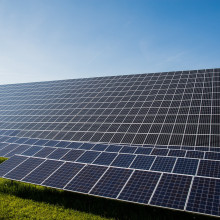
00:56 - Spray-on ultrathin solar panel perovskite
Spray-on ultrathin solar panel perovskite
Sascha Feldmann, University of Cambridge
Solar power makes an important contribution to renewable energy production. But the present generation of PV - or photovoltaic - panels are based on extremely heavy chunks of silicon. These are the black slabs that you see on the roofs of houses. And not only do they cost a lot in energy terms to make and install, they’ll be a hefty recycling cost to pay in a few years time when they need replacing. Which means that the discovery by Cambridge University scientists of a new panel material, known as a perovskite, that works as well as silicon but is so thin you can spray it onto a surface, is welcome news. Speaking with Chris Smith, Sascha Feldmann...
Sascha - We discovered a new material that could actually revolutionize solar panels on your rooftop. It's a so-called perovskite, and a perovskite is a class of crystal structure that is based on a mixture of organic and inorganic building blocks.
Chris - In terms of its ability to generate electricity, will the basic principale be the same?
Sascha - It will to some extent. We will still absorb sunlight, and the energy that light carries will then generate current that we can use to store electrical energy. But the way this one works is slightly different, in that usually you would expect for something like silicon, very precisely engines atomic crystal structure, where every atom sits exactly where it's supposed to be. That matters because if you absorb light and generate charges you also want to extract those charges and get them out of this material, so you don't want them to be stuck at disordered sites. But here we now have actual disorder that we wanted to be there because it's helps to localise these charges.
Chris - What's the material, the perovskite you've invented made from?
Sascha - So there's quite the mixture of different ions in there but most pronounced are lead and iodide and then also some bromide. They self assemble into a very disordered energy landscape. You can think of a mountain and valley kind of structure and this material and the charges will just roll down to the minimum which is the valley and then they will just accumulate and we get more and more of them and then we extract them very easily.
Chris - So when you say, you you get a landscape you get peaks like the mountains and then valleys it dips between them so it's self assembles into that sort of architecture, in energy terms and when the sunlight hits it the charges will roll down like rainwater going into the valley and you get a puddle there. Rather like we would tap off a river, you can tap off the flow of charges that have collected there?
Sascha - Exactly. That's exactly right. And the funny thing is we did not anticipate that this would happen. We actually wanted to make a very flat landscape and just found this to assemble in this way. But then we found out that as you say it's actually easier to extract from these fields charge bottles.
Chris - How do you get a pipe into the puddle then, to draw off the charge - if it's so disorganised? How do you know where those puddles are going to be and therefore how do you get at the charge.
Sascha - We actually don't. So far we just randomly Petter and substrates and then hope that some of these puddles actually lines with our electrodes at the bottom, but due to the fact that these are so incredibly thin, which is just through 100 nanometres or so or thousandth of the diameter of a human hair. It's quite easy to just somewhere have an electrodes sitting because these pilots are still quite small.
Chris - I suppose a massive advantage is given it's so thin, compared with a massive slab of silicon we currently put on the roof where you've got arrays of solar panels weighing a ton or so to to generate a modest amount of electricity. This is gonna be extremely light. So there must be enormous numbers of benefits of not having to transport heavy materials, not having to recycle enormously heavy metals etc. that come from this.
Sascha - Yes. So you can envision actually something like flexible electronics from this because we work on such thin films, we can just print them like an inkjet printer on top of plastic substrates so to say. You could even integrate them into something like a jacket for example and then your jacket that you wear, actually powers your phone and the answer that would be the dream.
Chris - To become a human solar panel?
Sascha - Yes basically. And also it can be used as a display in the same way that we absorb light energy to get electrical energy out. We can now think of putting electrical energy and get light out.So this seems to work. as well.
Chris - In terms of its performance though because that's the key thing isn't it, is how good is it and can it give silicon the traditional technology a run for its money. Is it any good?
Sascha - So actually it's performing astonishingly well, around 25 percent efficiency and you have around the same number of for silicon. So it's it's reaching that level of efficiency which is really stunning given how easy and cheap this will be to produce.
Chris - And in terms of its environmental footprint your materials got lead in it. That's not very nice. Is it? We're trying to reduce our lead usage if we can, because it has toxic and has other effects. What's the environmental footprint of this?
Sascha - So that is correct there is lead in this composition and we need it as of now. But if you have a bit of a comparisons to the dimensions of lead we need here, you need to envision just coating a whole football fields full of our solar material because it's so thin - just a hundred nanometres or so. The amount of lead you will need to do this job is still less than what's on the top of your nail off your thumb for example. So compared to something like a lead sulphide based battery that every one of us has in their cars right now that's really very, very, small amount of that.
Chris - and it won't fall apart in five minutes?
Sascha - So they do fall apart in a much shorter time than silicon does right now. But given that we only have been working on this for the last eight years or so, the increasements we got into lifetimes are astonishingly high!
Phil - Gosh that's so cool. I can't get over it spray on solar panels. That's Cambridge University Sasha Feldman. That work appeared this week in the journal Nature Photonics.

06:37 - Hiccups help baby brain development
Hiccups help baby brain development
Kim Whitehead, University College London
Hiccups are uncomfortable and always seem to happen at the worst times. And there’s not a clear explanation yet for why we have them - they’re involuntary spasms of the diaphragm that don’t seem to have a purpose. But new evidence shows that for babies, hiccups might actually help their brains develop - meaning adults might get them as a relic from our infancy, when they were genuinely useful. UCL scientists suggested this after looking at thirteen babies, who happened to be hiccuping while their brains were being scanned for other studies. They found spikes of brain activity that they think help the babies figure out which parts of their bodies are which. Phil Sansom got the full story from lead author Kim Whitehead…
Kim - So what we found is that when infants have a hiccup, they have a large change in brain activity immediately after the hiccup.
Phil - Is that them sensing their own hiccup, basically?
Kim - The way that we would interpret it, yes, is that the information from the feel of the diaphragm muscle contracting and potentially the sound that the hiccup makes, the 'hic' noise, is reaching the brain and being processed by the brain, by these young babies. And because we have a little sensor on their belly as part of our setup, we were able to look at the brain activity in real time.
Phil - Did you have to wait a while for them to hiccup? Because am I right that babies are quite big hiccupers, right?
Kim - Exactly. It all relies on the fact that babies are big hiccupers. This was a retrospective analysis, we started to become interested in it, and I realised that some of the babies hiccuped by chance spontaneously during recordings that were being acquired for other scientific questions. And because they hiccup so often - so they hiccup about 1 percent of the day - just by chance we will capture some of these hiccups during our experimental protocol.
Phil - Got it. So you've got your babies with the sensor on their chest. But how do you measure what's going on in their brains?
Kim - So we use a technique called EEG, and it stands for electro-encephalopathy. And basically it's able to record the ongoing electrical activity in the brain. The EEG is completely painless, we can record it from the scalp with the little sensors, and the great thing about it is that it allows us to see brain activity change millisecond by millisecond, so that's the level of a thousandth of a second. So we see three separate brainwaves that look quite distinct. And what we've seen from other aspects of our research is that when the brain processes sensory information, it wants to get multiple parts of information. So for example it might want to process where in the body that came from. And then those later brainwaves are still a source of a lot of research interest, but they're potentially about extra-sensory information. So, "are other things happening at the same time as this sensory input that we're receiving? What other aspects can we classify in the brain?"
Phil - And then what are the consequences of big spikes in brain activity when you're hiccupping, for a baby?
Kim - So we know that brain activity is correlated with different outcomes, for example, in the milestones at school. But that's really just a correlation, so with human data it's difficult to prove what is causally related to brain development. But based on people who work with animal models of development in early life, they suggest that these really big brain waves that are very typical of the early life period help to strengthen sensory networks in the brain, at a time when the brain is just starting to establish those networks I was talking about. We have a network for touch, a network for motor control, etc. And it's useful for the immature brain to have a huge brainwave, where lots of brain cells get activated at the same time by a sensory stimulus, because it helps them to link up an experience that happens at the body surface - or the muscles of the body - helps to link that with brain pathways. And we all need that, as we grow up, in order to be aware of our surroundings, be able to interpret sensory signals.
Phil - So the hiccups might be really good for the developing baby brain?
Kim - We think that they may have a role in the developing baby brain, exactly.
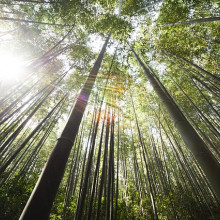
11:31 - Building with bamboo
Building with bamboo
Darshil Shah, Centre for Natural Material Innovation, University of Cambridge
We’re always looking for ways to save the planet. One potential thing that might help is building houses from more sustainable materials to cut the massive carbon footprint imposed by concrete. One candidate, that’s fast growing and strong, is bamboo, which also turns out to have some interesting thermal properties too, as Darshil Shah, from Cambridge University’s Centre for Natural Material Innovation explains to Chris Smith...
Chris - First of all, why bamboo as a building material - what's exciting about it?
Darshil - Bamboo is a fantastic material; it grows really fast: there are over a thousand species of bamboo, some of these can grow at a rate of a metre a day, or one millimetre every 90 seconds! While it grows it captures carbon as well as stores it within the material, and it is also abundant in certain parts of the world.
Chris - Is that bamboo in front of you? That's like a cannon!
Darshil - Yes.
Chris - And can I see that?
Darshil - Of course you can.
Chris - This is huge. Probably, what, 10 centimetres across, this bamboo.
Darshil - It can grow substantially thicker as well, and the stems - the cell wall - maybe about 15 to 20 millimetres thick; and they can grow up to 20 to 30 metres tall!
Chris - But you alluded to this just now when you were saying, you know, this is a tube; that's not ideal as a building material is it like that for all kinds of applications?
Darshil - No exactly. So engineers would like to convert it into some form of beam material or as panels which can be used as walls, floors and these are converted into those sorts of materials by cutting these columns into strips and then blending them into rectangular shapes and then thereafter gluing and.
Chris - And is that what that is? Because you've got some it looks a bit like the size of a big house brick.
Darshil - Exactly and these can be substantially longer three metres and they can also be in board form as well.
Chris - So you've given me as I say something about the size of a big house brick and looking at it, I can see that it's made of lots of little pieces of wood which have all been glued together. So you've cut sort of they're about centimeter and half by half a centimetre wide chunks and then they've all been presumably glued together. How strong is that?
Darshil - So bamboo has the same stiffness as wood, but it is substantially stronger than wood.
Chris - When I introduced you I said that you've discovered some interesting thermal properties about bamboo this week. So what was the motivation for doing that why were you even interested in that and how did you do it.
Darshil - Well yeah Firstly there has been a lot of research on the cell structure of bamboo and its relation to mechanical properties and some of this we have done ourselves, but there has been little research into how the structure is related to thermal properties. The amount of heating or cooling that is required in a building is fundamentally related to the properties of the materials that are made from particularly how much heat they conduct and how much heat they store. Also a better understanding of the thermal properties of bamboo would provide insights into how to reduce the energy consumption of a building and the fire behaviour of a building. If we are to make fire safe buildings, we need to understand the thermal properties of these materials.
Chris - So how did you scrutinise your bit of bamboo.
Darshil - What we did was we actually took shavings off the bamboo and then we look under an atomic force microscope and what it does, is it heats the probe and you touch the surface of the bamboo and as you move the probe across the heat is conducted or not. That gives you a visual image of variations in the thermal conductivity.
Chris - And what did you find?
Darshil - We find that bamboo is a structure with fibres produced in a manner in which there are thick and thin adjacent cell wall layers; the thick ones, which are oriented along the fibre axis, provide stiffness and strength in that direction, and also conduct heat in that direction; whereas, the thin cell wall layers do not conduct as much heat in that direction.
Chris - May I infer from that then that, if I were to try to push heat through a piece of bamboo, it would go along the bamboo quite well but through the bamboo quite poorly?
Darhsil - That is correct.
Chris - So how does that affect the way in which we are going to make more materials like this big brick you've made with little pieces of bamboo or whole buildings out of bamboo. How is this going to change the way we fundamentally use it?
Darshil - Firstly we realise because bamboo is a combustible material, we need to protect it in some form so that the properties in that direction do not soften so rapidly and this is commonly done either through an intermittent paint or using some form of protective layer like a gypsum board, but also looking at graphine and how coatings from graphine might be able to divert heat from the bamboo.
Chris - They were talking about how we're going to live on Mars this week and they were saying that they're going to grow bamboo on Mars. I think it's a great material to grow in the first human settlements on Mars for all the reasons you said it grows so quick, and the kids do stuff with it, and it's a little bit of home from home. So maybe you should too. But there is an opportunity there.
Darshil - That is very interesting because I was watching Avatar a while back and I saw bamboo forests on that as well. And it's definitely something we should do we need to look into more anyways!
Phil - I'm excited because that opens up the possibility for panda colonies on Mars!
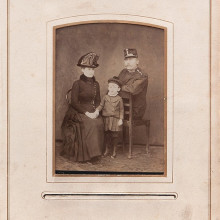
16:52 - Sex in the city: when dad's not dad
Sex in the city: when dad's not dad
Maarten Larmuseau, Leuven University
If you think you know who your relatives are, you might want to think again. Because, according to a new study, about one in every hundred of us doesn’t have the dad with think we do. This is called “extra-pair paternity” - it’s where a man ends up bringing up another man’s child - and city living, as well as lower socioeconomic status, make it more likely to happen. Researchers at Leuven University, in Belgium, discovered this by tracking down 513 pairs of men who, according to parish records, shared a male ancestor up to 500 years ago in their family trees. Because men inherit their Y chromosomes exclusively from their fathers, if there’d been no naughtiness in their family trees, the genetic barcodes of the Y chromosomes of each of the pairs of men should match. But, in some cases, they didn’t, with the obvious implications! And by using additional genetic techniques, they were able to work out when in the family history the assignation must have happened. Speaking with Amalia Thomas, Maarten Larmuseau...
Maarten - For the first time we reconstructed the historical patterns of extra pair paternity across the last centuries within our Western populations. What is 'extra pair paternity'. Well it is an event when a man was unexpectedly not the biological father of his legal child. What we found was that the 'extra pair paternity' rates were lower overall around 1 percent, but depending on social context we find that the highest 'extra pair paternity' rates were observed among urban families with low socio economic status, especially in the 19th century.
Amalia - And how did you find out that these women had been cheating on their husbands?
Maarten - But it's not only cheating. It can also be the result of sexual aggression'. Extra pair paternity' has potential different causes. So what we did was find persons who are living today with a common paternal ancestor in direct paternal line; if they have the same Y chromosomes - Y chromosomes are the chromosomes that each male get from his father - in a paternal line, every man should have the same Y chromosome, or variants. If that is not the case then at least one 'extra pair paternity' event happens across the generation.
Amalia - So you studied the genes of over 500 pairs of donors who are alive today and compare that to the family records dating back up to 500 years. How can you be so sure that records that are so old are accurate?
Maarten - We are quite sure about those genealogies, based on civil records and parish records. If we didn't find a biological connection between presumed related persons then we know that there is at least one 'extra pair of paternity In the past.
Amalia - What have you found out from this comparison?
Maarten - Well that the 'extra pair paternity' rate is quite low in average. It's always around 1 percent. But what we saw now is that there were quite differences between socioeconomic classes, especially the low social classes in the 19th Century, they had a 10 fold higher exit per paternity rate than formers in rural areas and this is quite surprising. We didn't expect this! We expected more in aristocratic families, especially because there is a lot of references to adultery in the 17th century in literature and theatre plays. So this looks like based on our results that it's not the case.
Amalia - Could you guess if you don't know exactly, why it's the socioeconomic status population, density and particularly the 19th century where this happened the most?
Maarten - Well we don't have a real explanation because we cannot interview older people any more and say what is the reason. Is it because of adultery is it because of sexual aggression and rape? We cannot ask them again. But what we see is that in the 19th Century there was a lot of social conflict, low social classes lived in very poor conditions. We also had a lot of cholera epidemics, especially in Belgium and the Netherlands where we looked. After the Industrial Revolution there weren't that good conditions and there were much higher differences between the social classes. So after all it was not so surprising that we could see differences.
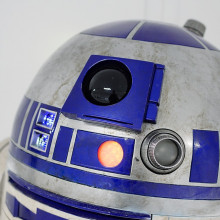
21:34 - 3d-TV
3d-TV
Peter Christopher, Centre for Molecular Materials, Photonics and Electronics, Cambridge University
Here’s a story from a long, long time ago in a galaxy far, far away! If you’ve ever wanted a 3D holographic-style display like the one Princess Leia uses in Star Wars, you may be in luck. Researchers in the UK and Japan have invented a device that uses sound waves to produce a 3D video, audio and interactive touch display. And one of the best parts - no flimsy red and green glasses to wear! Nadeem Gabbani asked Peter Christopher, from the Centre for Molecular Materials, Photonics and Electronics at Cambridge University, to take him through how the new gadget works…
Nadeem - "Help me, Obi Wan Kenobi. You're my only hope." Most of us can remember hearing those famous words and watching - and marveling - as R2D2 projects, in 3D, Princess Leah's plea for help to Luke Skywalker and Ben Kenobi in the first Star Wars blockbuster. It was all very futuristic. But now the future is here! Sort of. Scientists have created a new type of device that uses sound waves to produce 3D video, audio, and an interactive touch experience, all without the use of glasses or additional equipment. Peter Christopher researches similar technologies at the University of Cambridge.
Peter - For many, many years people thought that wouldn't be possible. Then in the last few years we've begun to see people taking steps towards having 3D displays, and full 3D displays as opposed to the tricks that are used to make things appear 3D inside a 3D cinema or on a 3D television.
Nadeem - The display itself is about the same size and shape as a microwave, but with the door removed. And this where the magic happens: the display actually uses sound waves to produce an image.
Peter - The technology these guys are using is very clever. They are taking effectively a speaker wall, a very small speaker wall, and a second one matching it, and are using that to form a standing wave. So I don't know if you've ever been to the beach where there isn't much of a current, and you throw a log or a ball out to sea, you'll see that the waves will go up and down but the ball will stay still. And with clever manipulation of the waves you can actually move the ball around without actually moving the material.
Nadeem - The display works on the same principle but moves the ball faster than the human eye is able to resolve, producing a persistent image. To add colour, the ball is illuminated with colour LEDs at distinct points during its travel corresponding to the colour of the same point in the image it's trying to reproduce, just as if it were a pixel. This is a very interesting approach for making 3D images. But why are they using sound rather than light?
Peter - I hate to say this, 'cause obviously they're my competition, but I think acoustic technology makes more sense in the short term. The wavelengths of light that people can use is much, much, much smaller, which requires you to control light on the scale of nanometres; whereas if you use acoustic, or sound-based technology, you only have to control it on millimetres.
Nadeem - And how small is a nanometre?
Peter - So a nanometre is ten to the minus nine of a metre, which translates to about ten atoms.
Nadeem - But then how do they reproduce sound? The speakers in the display vibrate at a frequency of 40 kilohertz, or 40,000 times a second - well outside the range of human hearing.
Peter - The ultrasound waves used for controlling the ball are very high frequency, much higher frequency than you can hear. And the scientists are using a technique known as pulse width modulation to superimpose a much lower-frequency sound wave on top, not in an entirely dissimilar way to, say, your old FM radio you would have as a kid.
Nadeem - Cleverly, the system is not just able to simultaneously reproduce images and audio, but also feedback through tactile touch. This works in a similar way to the image production except instead of a ball being trapped and moved, it would be your finger. This new type of display could enable a whole new range of applications which require a 3D interaction between the user and the content, such as entertainment, training, or gaming, for example.
Peter - I believe the technology is impactful primarily because the image is actually in space. So if you go to a 3D cinema or have a 3D television in your home, or you use an Oculus Rift or other heads-up display; if you use those technologies they're using tricks to trick your eyes into thinking you're seeing a 3D object. This technology is cool because it's a step towards having the first truly 3D displays, as opposed to ones that only look 3D under a very specific set of circumstances. This technology is also very cheap in comparison to 3D cinemas and you could do that for hundreds, rather than hundreds of thousands, of pounds.
Nadeem - So it sounds like what was once “a long time ago in a galaxy far, far away”, is now very much within reach.
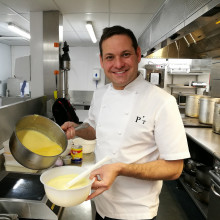
30:03 - Making egg custard with Tristan Welch
Making egg custard with Tristan Welch
Tristan Welch, Parker's Tavern
Whether it’s hot or cold, like most of us get our custard by making it from custard powder, or straight from the tin. But, to a purist, neither of those are actually custard at all. The real stuff involves eggs, cream, and careful cooking. And to find out more, Phil Sansom went over to Parker’s Tavern in Cambridge to meet head chef Tristan Welch...
Tristan - Custard is probably up there with my top three sauces of all time!
Phil - Why does it rank so high?
Tristan -It's home memories, it's childhood memories actually, it is a very comforting creamy sauce that reminds me certainly of great family occasions.
Phil - Why don't you show me a little bit about how to make it? Let's start off!
Tristan - Yeah absolutely. So let's start by making a really classical custard or the French might call it "Creme Anglaise". All we need really is egg yolks, cream and sugar with an infusion of vanilla.
Phil - At a fundamental level, is this what custard really is?
Tristan - This is the complete definition of custard. This is what every other custard has been based upon.
Phil - Eggs, milk, cream, and sugar with a bit of vanilla.
Tristan - Custard is the building block. One of the foundations of the modern world's desserts and anything else to do with a kitchen, a quiche for instance.
Phil - No.
Tristan - Of course the quiches are custard.
Phil - I don't believe you.
Tristan - Yeah a quiche, a flan and ice creams and other custards actually.
Phil - Ice creams a custard?
Tristan - Yeah absolutely. Actually what we're doing here is a classical custard base but if you take this custard and you put it in ice cream machine - you've got vanilla ice cream!
Phil - Is it still custard though?
Tristan - Of course.
Phil - I'm finding out that a lot of things are custard but I didn't realise everything is custard!
Tristan - It all comes down to custard.
Phil - Let's make a start on this. You've got your pan here on this induction stove, this mini almost hot plate.
Tristan - That's basically ticking away with our milk, cream of vanilla and creating an infusion. Now in this bowl here, I'm mixing sugar and egg yolks and that's going to give our milk and cream consistency, because when the egg yolks cook the proteins coagulate a bit it creates a viscosity, so a thickness to the milk and cream and that is really what we know as custard. So, are milk and cream has been infusing with our vanilla for about 20 minutes a gentle simmer. The aroma is just fantastic! It's like childhood memories coming back. It's like a sweet shop. Now I've got eggs and sugar, I'm gently going to pour on the milk and cream - this is called tempering the eggs. This is really important. If you pour the eggs into the milk and cream, it will scramble them. So you pour about half of the milk and cream onto the eggs. Then put that into the pan safely without splitting.
Phil - And what do you mean by splitting?
Tristan - Basically if you cook the eggs too fast, it looks a little bit like scrambled eggs floating in water.
Phil - And if I understand correcrtly, custard is all about cooking it to the point before it splits and you get the scrambled egg horribleness?
Tristan - Absolutely. The magic temperature here to get it in to is about 82 degrees centigrade.
Phil - You can see now it is already thicker.
Tristan - Yeah. Absolutely. Mmm. Never trust a chef who doesn't eat his own food.
Phil - Is it my turn?
Tristan - Yeah. You have a taste!
Phil - That's gorgeous.
Tristan - Shall I show you how this goes wrong?
Phil - Yes.
Tristan - Ok. Let's overcook it goes completely. This goes against my DNA! By the way so what I'll do, I'm going to take out half of it now. So only ruin a part of it! I'm just taking it above a safe level to cook at for an egg. So I'm essentially going to boil it and you can see the bubbles coming up there now.
Phil - Oh no. There's little solid bits forming in this beautiful lovely custard.
Tristan - There you go. Watery. It's like essentially is curds and whey! It has started to look disgusting, starting to smell disgusting.
Phil - So Tristan. How often do you make custard in your kitchen?
Tristan - More than daily. Our pastry chef probably makes a custard about 12 to 15 times a day.
Phil - That's a lot of custard.
Tristan - It's a lot of custard.
Phil - A lot of eggs! Now I know that if someone couldn't eat eggs for whatever reason, this would be a good custard alternative. What are you making now?
Tristan - So this is custard powder. This was the first custard that I knew and it's the first custard which a lot of people knew in the U.K.
Phil - It's custard as I would make it.
Tristan - So this is a custard powder. Basically the recipe is vanilla extract, corn flour and colouring. We actually use this in some of our recipes in the pastry kitchen, instead of cornflour because it is so high in corn flour.
Phil - Now how can it be custard, if it doesn't have that crucial ingredient the eggs?
Tristan - It's like vegetarian burgers without the beef; poetic license is allowed, I think.
Phil - How does it work then if it's mainly corn flour?
Tristan - Because it's got the corn starch in it. You have to mix it with the cold milk and you bring it gently up to the boil. So what I'm going to do here, I've got a custard powder and you've got to add a little bit of sugar to it and our milk. I'll just mix those. You have to keep it stiring, otherwise what may well happen is the corn starch will fall to the bottom of the pan and then start to cook before the res of it does - that will get you lumps again! I can feel it now on the whiskthere, I can feel it getting slightly thicker. If it was green you'd think it was slime right? Well that is our powdered custard.
Phil - The powdered custard has a lot more yellowy colour and thicker texture.
Tristan - Yeah I think the colours are a little bit lighter. That's really dependent on the type of egg yolks used that you use as well. So if you buy the bright yellow egg yolks, that will change the colour but the consistency is something else. I mean an egg custard is a real occasion. It's expensive compared to Bird's Custard it really is, but it's really delicious. It's a bit like a Rolls Royce vs. a Ford Cortina. You know when you go egg custard, it's very difficult to go back.
Phil - You've done all the cooking. I guess I'm on washing up duty?
Tristan -Yeah. Now please!
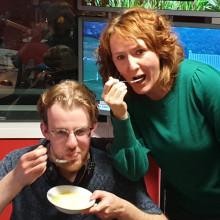
36:44 - The chemistry of custard
The chemistry of custard
Ljiljana Fruk, University of Cambridge
Now that we know the how of making custard, it’s time to look at the why. What’s happening at the molecular level when custard gets cooked? Speaking with Chris Smith and Phil Sansom, chemist - and chef - Ljiljana Fruk...
Chris - Now Ljiljana, we've heard from Tristan about egg and egg proteins. He says they're critical to his original custard recipe, so let's look at that first. So what is the egg yolk doing to the mixture to make that happen?
Ljiljana - So egg yolk is full of proteins and fats and basically if you would centrifuge it, you would divide the egg yolk, you will see that there is a little bit more of the liquid part and a little bit more of grain part in the eggs. This is composed of fats and proteins mixed together. So when you basically heat up your egg, when you are in the process of making the custard, you are basically unfolding the protein structures. Proteins usually have globular structures.
Chris - Like a ball of wool?
Ljiljana - Yes. So they are like three dimensional and when you heat them up you unwind them. So they become a little bit elongated - longer. You do this because the heat is used as a catalyst to destroy a particular molecular bonding, by which of these proteins are held together.
Chris - Do we know what that is?
Ljiljana - So this is disulphide linkage. The linkage between these two thiols and this thiol molecules. And these thiol molecules they actually sometimes are very smelly.
Chris - And if you break those bonds, the protein strings out into long chains. But why does that make the custard then?
Ljiljana - This long chain now have the ability to interact with each other, a little bit easier. So what happens, you are creating almost a gel like structure and the beauty here is that you do need to have some minerals, so you need to add a little bit of salt and you need to add sugar. Sugar forms a tiny little coating on top of this molecular structures, which are now unwound so they don't kind of assemble very quickly. They don't form a very rigid structure and they don't turn hard.
Chris - So rather than a series of balls sitting next to each other, once you allow them to chain out into strings you can imagine that they're going to basically link the molecule - this raft of proteins or other things like the sugar - all together so you get this jelly forming, and that's what it's doing?
Ljiljana - Exactly; and so this process needs to be slowed, because if you heat up suddenly.
Chris - That's my next question! Why does overheating - and 'overegging' [excuse the pun] - why does that make a difference?
Ljiljana - Because you are then removing this layer of sugar that protects a really strong binding and strong kind of unregulated process. You are just destroying it if you heat slowly dispersing it, it has happened slowly or slowly interlocking all of these structures and you are creating nice gel.
Chris - So that's how egg works. What about the more - for the want of a better phrase - poor man's custard; the stuff that comes out of a packet that - we learned from Tristan - does not have eggs, it's based on starch molecules. How does that work then?
Ljiljana - Starch molecules are also involved in thickening information of this similar gel as the egg is forming. It is just the process is a tiny bit different.
Chris - So what actually is starch?
Ljiljana - Starch is the polymer made of glucose. That means that there are many glucose sugars which are bound together in the long chains.
Chris - So that's why it's similar to what the egg does: when you unchain the egg by heating and breaking those sulphur linkages, you get long chains that are sticky. You do the same thing with the starch.
Ljiljana - Yes, starch is made of glucose that doesn't have any thiols. So the principle is a little bit different, because the structure of starch is different so it doesn't contain any thiols. So, instead, if you heated starch in water, the granules are formed, which are embedding lots of water, they swell. As long as you keep on heating, the viscosity of the whole solution will change because now you have these huge granules, which are formed and at a certain temperature, that will burst; and as they burst, they release tiny pieces of molecules, which then act to cross link these long linear pieces. So, basically, what you are now creating is a gel, which is a combination of different molecules and molecular pieces, made of glucose, which previously have been part of the starch.
Chris - So it amounts to the same outcome. It just uses a different chemical root and different ingredients to get it. But the basic premise is that you end up with long chains of molecules that are also cross linked together. That forms this challenge.
Ljiljana - That forms this beautiful texture that we all like.
Phil - Liliana you've brought in some custard for us to try. But it's not a custard that I've seen before, what's the story behind that?
Ljiljana - This is the best selling Croatian custard and it actually it is a poor man's custard because it doesn't have any eggs, but instead it uses starch and a little bit of sugar and it can be done with water, it doesn't necessarily require milk but it's much tastier if there is a full fat milk that is used for making this. Actually this was the kind of a tiny social revolution when this starch based custard came and became available to the masses. Eggs are expensive and they have been expensive and so they were considered a luxury product and anything that was made with eggs was a luxury product. So having a possibility to have a wonderful custard, made without eggs gave the opportunity to everybody to enjoy a beautiful dessert.
Phil - Equal opportunity custard!
Ljiljana - Equal opportunity custard. I need to tell you that in Croatia, we have this luxury version custard which we all really adore and it's made with liquor which is made of rose petals!
Chris - Oh wow. Well next time you come, you can bring that because you're going to be opening a restaurant every time you come on this programme. We were talking about your restaurant you're going to open in Zagreb, a very beautiful city! Hello to my Australian friends at the Australian embassy in Zagreb. Libby Petrovich is the Australian ambassador, who made me very welcome couple of years ago. I'm looking forward to coming back and seeing them all. I'll I'll drop in and see your restaurant - you're going to serve this?
Ljiljana - You should. Oh we will definitely serve the rose petal version!
Phil - I'm excited. I want to go see it!
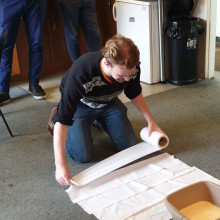
43:33 - Walking on custard: shear-thickening fluid
Walking on custard: shear-thickening fluid
Mazi Jalaal and Mike Cates, Department of Applied Maths and Theoretical Physics, University of Cambridge
Did you know that you can actually walk on custard? It’s true! Well, specifically custard made from custard powder. It’s because custard powder is mostly cornstarch, and when you mix cornstarch with a bit of water, you create a liquid that acts like a solid when you try to move it too quickly. The stuff is lovingly called “oobleck” in children’s science demonstrations. It’s a great demonstration of a non-Newtonian fluid, specifically one that is ‘shear thickening’, which means that it becomes thicker and more viscous the more shear force you apply to it. Phil Sansom had a go at making some for himself...
Phil - Oh, that doesn't look good. Oh no!
Mazi - You do not want to walk on this.
Phil - That's a liquid!
Mazi - That's a very liquidy custard, yes. I don't think you even want eat it.
Phil - That is me with fluid dynamist Mazi Jalaal. And the reason we're so disappointed is that, while it's true you can walk on custard, you can't do it by following the recipe on the back of the tin. Here is Mazi explaining how it's supposed to work.
Mazi - Most of the fluids that we're familiar with, like water or honey, are Newtonian. So basically what it means is that they have one, constant viscosity. But many materials - like many foods - their response depends on how fast and how hard you push them.
Phil - So if you hit it harder it becomes more viscous? Is that right?
Mazi - Again, depends on the material. So let's think about ketchup, for instance, which is a very common example of food for shear thinning materials. Ketchup, if you hold it, it doesn't come out; but if you put enough stress on it, it starts to flow. So we basically somehow yield it, and after that it looks like a shear thinning material, meaning the harder you stress them the faster it flows.
Phil - That's why you hit the ketchup bottle to get the ketchup out.
Mazi - That's exactly what you do.
Phil - That's shear thinning, where the liquid gets runnier the more force you apply. The other type of non-Newtonian fluid is like cornstarch and water: that's shear thickening, getting thicker when you apply force to it. It happens when you have these tiny particles suspended in a liquid.
Mazi - For instance, in cornstarch there are basically starch particles that interact with each other. That gives this very strange behaviour. Basically these suspensions are in water, and if you press them hard enough the solid particles of starch start to somehow make some sort of friction onto each other.
Phil - Is that something that applies to other materials in other places?
Mazi - It is applied to almost any industrial fluid that you can think of. Cosmetic industries, the oil industry... most of the fluids that you're dealing with are not Newtonian.
Phil - The science of dealing with flowing materials like this is called rheology. And if you're a rheologist like Mazi you might want to design a material to have the perfect amount of shear thinning or shear thickening. Now this stuff can get kind of extreme. I went to find out more from Lucasian Professor of Mathematics Mike Cates.
Mike - There's a guy called Norman Wagner who did have a big contract with the US defense funding agency. And they were wondering whether if you actually shot bullets at this fluid it could stop a bullet. And the answer is: not quite. What you have to do is, you have to get some of the shear thickening fluid and you have to laminate it between layers of Kevlar. Then that combination does seem to be capable, certainly of stopping a stab wound, and possibly a bullet.
Phil - Yep, you heard that right. Bulletproof custard.
Mike - The thing about the dense custard powder suspension is that it is a fluid; we know how it thickens like that, and it jams; nonetheless it can fracture and fly to pieces. But if you put it in that sandwich with the Kevlar layers on the outside, that holds it in. The combination can stop a projectile; maybe a bullet.
Phil - Is this actual cornstarch, custard powder, that we're talking about here?
Mike - Cornstarch has become actually quite a good benchmark model system. It has just the right interactions; particles which are very hard; quite smooth; and also have some sort of little repulsion between them. And cornstarch, when you put in water, the particles become charged so that they automatically get this repulsion. Of course there are much more sophisticated synthetic systems where you make specified particle size, perfectly spherical particles; and some of those are certainly better than cornstarch in any particular application, like a bulletproof vest. In particular, cornstarch in water, if you came back in a couple of weeks time would be pretty smelly. Bacteria love cornstarch; they're going to eat your clothes.
Phil - So maybe don't expect Bird's to become the number one military contractor. Anyway, back to Mazi and I, where we've managed to perfect our formula.
Mazi - So this one has almost three quarters of the custard powder and one quarter water. So now what you see is a shear thickening fluid.
Phil - Is it working?
Mazi - It is working actually very well.
Phil - Can I try? Oh yeah, wow! It's really hard to mix when you're trying, but then when you just glide it through the liquid it goes easily. That is bizarre.
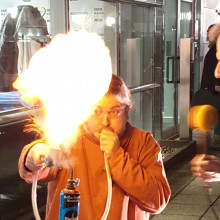
49:33 - Exploding Custard Powder
Exploding Custard Powder
Dave Ansell, Science Communicator
Not only is custard a chemical cornucopia and a great case study for fluid dynamics, custard powder sometimes demonstrates another physical phenomenon, and that’s combustion. Custard powder is flammable, and Chris Smith is out in the car park with Dave Ansell to prove it to you...
Dave - Well custard is a fuel like any other, like wood or oil. It has got hydrogen and carbon in it. You burn it, those will react with oxygen and give off energy. Normally, this will happen really slowly, in the same way that if you have a big lump of wood it will take ages to burn, twigs will take minutes, if you chop it down to a piece of paper it might burn in seconds. But the real thing about cornflour, which is in custard powder, is that the particles are microns across, maybe 10 microns across. So if you can get the oxygen to them, they'll burn very, very quickly.
Chris - And to put that into perspective, microns being tiny, those are the size of particles that come out of the exhaust pipes of cars. These are really tiny particles.
Dave - Very, very tiny. That's a millionth of a metre - is a micron.
Chris - And does the same physics apply to pretty much anything that's a fuel source, because you mentioned carbon, hydrogen and oxygen in the molecules for example. So basically anything that can work as a fuel, the physics applies?
Dave - Yeah. So if you can break up any fuel into very, very small particles and mix it with air it will burn very quickly. That's not just things with carbon and hydrogen in them; even things like titanium will do the same thing. So there was a titanium factory which blew up in 2014/2015 in the States, where they got some titanium dust, some spark ignited it, and the whole thing went off, bang.
Chris - And essentially, in terms of a real world application, a diesel engine or an engine that's making a spray of petrol vapour inside the cylinder, air-fuel mixtures work in the same way, isn't it?
Dave - Yeah, basically you're splitting up your fuel into very, very small particles, you mix it well, it'll burn. And the smaller the particles, the quicker it will burn. Probably the extreme examples of this is gas. If you mix gas with air really well, it will go off with a really, really violent bang.
Chris - And now you're going to show us how it works. You've lit a gas torch in front of us, which is keeping us warm on this very cold evening. You have a thing that looks like a gentleman's pipe from the 1800s, but with an exceptionally long piece of plastic tube on the end of it, going into it. And you have loaded the bowl of the pipe with...
Dave - This is custard powder.
Chris - Okay. And what are you going to do?
Dave - So basically we want to suspend this in the air, so I'm going to blow air into this pipe, the pipe's set off-centre so it kind of spirals inside the bowl of the pipe, so it mixes with air very very efficiently. And...
Chris - Shall we count down? Three, two, one, Dave's going to blow it in the flame...
*FIREBALL*
Chris - I don't have many hair follicles left now, or eyebrows, but there was an enormous fireball - basically that was about three feet across - and it went in a fraction of a second.
Dave - Yeah. It burns very, very quickly, lots of heat released. If that was a whole building going up then you'd have serious problems.
Chris - And it's the heat that's released from that, that then causes the air to expand and that of course is the explosive force?
Dave - Yeah. As with any explosion, heat causing gas to expand, that then hits things, blows apart buildings. I mean, whole buildings have been completely destroyed by this effect.
Chris - Dave, thank you very much for demonstrating it for us. Demonstrator extraordinaire Dave Ansell.
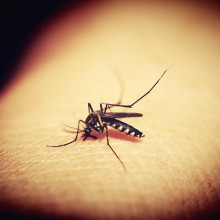
53:17 - QotW: Do mosquitoes prefer blood group O?
QotW: Do mosquitoes prefer blood group O?
Phil - Now to finish. Question of the week and this week, Adam has taken a bite out of this question from Vinnie.
Adam - Are you one of those people that mosquitos are just drawn to? Or like me, are you lucky enough that you get to be smug that mosquitos will only come to you as a last resort? Could your blood have something to do with that. I reached out to Immo Hansen, from New Mexico State University to find out.
Immo - There is one study from 2004 on the landing preference of Asian Tiger mosquitoes on people with different blood types. Shirai and coworkers found that this species of mosquitoes prefers to land on subjects that had blood group O compared with subjects of all other blood types.
Adam - Uh-Oh then, for people with O blood types. But how can a blood type impact what’s going on?
Immo - Blood types are defined by specific carbohydrates, or sugars, that are on the surface of red blood cells. When they applied these sugar antigens to the forearms of test subjects, they found that subjects treated with the H antigen attracted more mosquitoes than subjects treated with antigens of all other blood types.
Adam - These antigens are also the reason that people with A type blood can’t take from people with B type blood. The H antigen is found on all blood types, so if you only have that, you’ve type O blood, and can give to everyone, especially mosquitos apparently!
Immo - With this study the scientists confirmed an earlier study from 1972 performed by Wood and coworkers that shows that blood type O is more attractive than B, which is more attractive than AB, which is more attractive than A. A recent study from 2019 from Prasadini and coworkers, shows that yellow fever mosquitoes also prefer blood type O, if they can choose between the four different blood types in and artificial feeding system. The big question, however is how mosquitoes can distinguish between subjects with different blood types, since host blood is usually not directly exposed to the air. Mosquitoes find their hosts using their sense of smell. So there must be some differences in the olfactory cues that subjects with different blood types excrete but those are still unknown.
Adam - And it’s worth mentioning that blood type isn’t the only factor, there’s loads of chemicals in sweat!As flummoxxed points out on the forum, being pregnant, and even a few beers can change how mosquitos respond to you. Thanks to Immo for flying in with an answer. Next time we’re tackling this one, from Geoff.
Geoff - How is it that there are rising sea levels impacting some island nations such as the Maldives and Kiribati, yet 1000 kilometres in any direction there is no discernible sea level change at all?










Comments
Add a comment